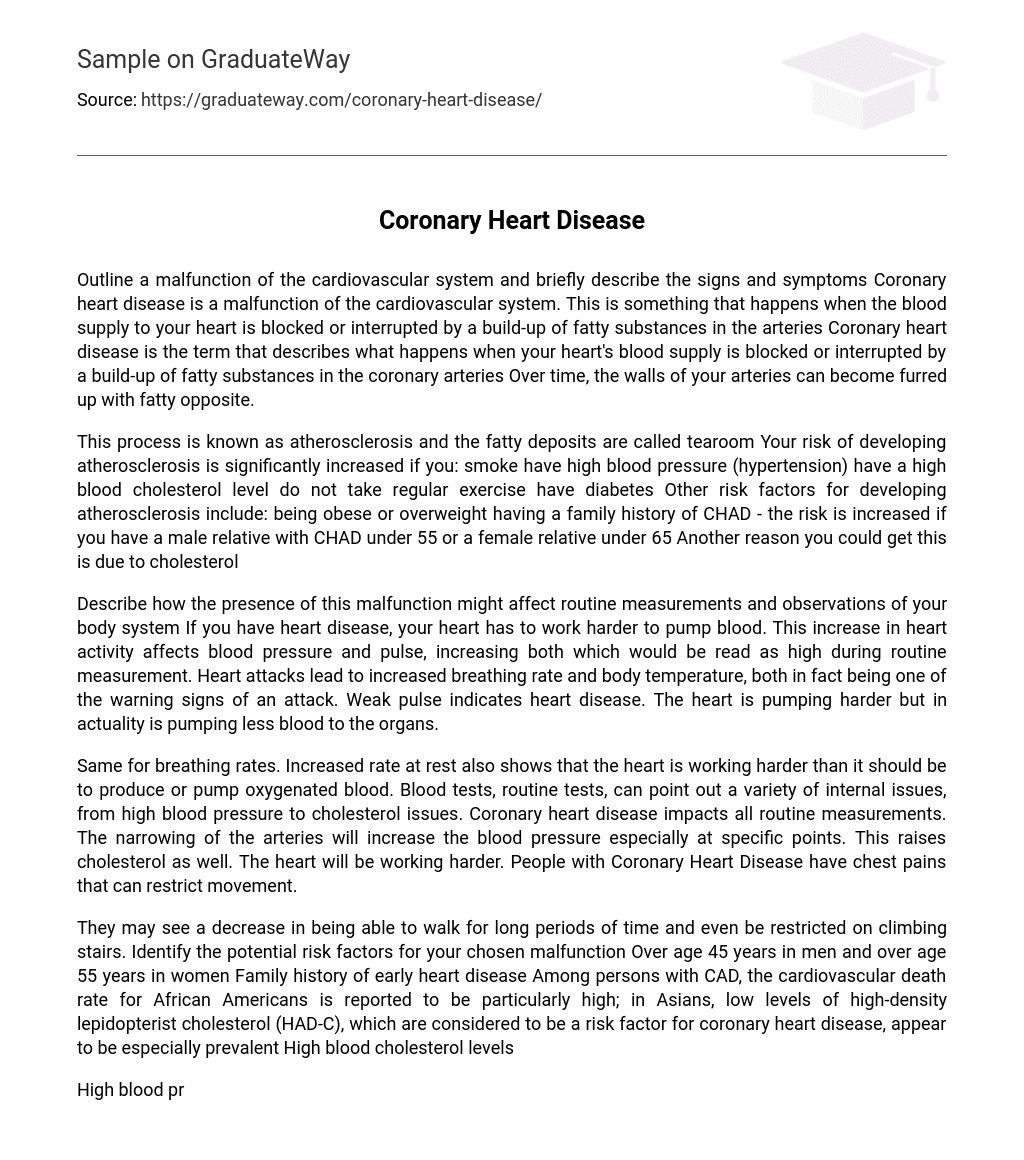Outline a malfunction of the cardiovascular system and briefly describe the signs and symptoms Coronary heart disease is a malfunction of the cardiovascular system. This is something that happens when the blood supply to your heart is blocked or interrupted by a build-up of fatty substances in the arteries Coronary heart disease is the term that describes what happens when your heart’s blood supply is blocked or interrupted by a build-up of fatty substances in the coronary arteries Over time, the walls of your arteries can become furred up with fatty opposite.
This process is known as atherosclerosis and the fatty deposits are called tearoom Your risk of developing atherosclerosis is significantly increased if you: smoke have high blood pressure (hypertension) have a high blood cholesterol level do not take regular exercise have diabetes Other risk factors for developing atherosclerosis include: being obese or overweight having a family history of CHAD – the risk is increased if you have a male relative with CHAD under 55 or a female relative under 65 Another reason you could get this is due to cholesterol
Describe how the presence of this malfunction might affect routine measurements and observations of your body system If you have heart disease, your heart has to work harder to pump blood. This increase in heart activity affects blood pressure and pulse, increasing both which would be read as high during routine measurement. Heart attacks lead to increased breathing rate and body temperature, both in fact being one of the warning signs of an attack. Weak pulse indicates heart disease. The heart is pumping harder but in actuality is pumping less blood to the organs.
Same for breathing rates. Increased rate at rest also shows that the heart is working harder than it should be to produce or pump oxygenated blood. Blood tests, routine tests, can point out a variety of internal issues, from high blood pressure to cholesterol issues. Coronary heart disease impacts all routine measurements. The narrowing of the arteries will increase the blood pressure especially at specific points. This raises cholesterol as well. The heart will be working harder. People with Coronary Heart Disease have chest pains that can restrict movement.
They may see a decrease in being able to walk for long periods of time and even be restricted on climbing stairs. Identify the potential risk factors for your chosen malfunction Over age 45 years in men and over age 55 years in women Family history of early heart disease Among persons with CAD, the cardiovascular death rate for African Americans is reported to be particularly high; in Asians, low levels of high-density lepidopterist cholesterol (HAD-C), which are considered to be a risk factor for coronary heart disease, appear to be especially prevalent High blood cholesterol levels
High blood pressure Cigarette smoking Diabetes mellitus Obesity Lack of physical activity Metabolic syndrome Mental stress and depression End-stage renal disease Chronic inflammatory diseases affecting connective tissues HIVE infection Lack of sleep Identify and describe the routine care that should be given to patients with this malfunction There are many ways you can prevent and treat coronary heart disease Eat a healthy balanced diet – A low-fat, high-fiber diet is recommended, including plenty of fresh fruit and vegetables.
You should limit the amount of salt you eat o no more than g a day as too much salt will increase your blood pressure There are two types of fat Saturated and unsaturated. You should avoid food containing saturated fats because these will increase your cholesterol levels. Foods high in saturated fat include: meat pies sausages and fatty cuts of meat butter ghee, a type of butter often used in Indian cooking lard cream hard cheese cakes and biscuits foods that contain coconut or palm oil However, a balanced diet should include a small amount of unsaturated fat, which will help reduce your cholesterol levels.
Foods high in unsaturated fat include oily fish avocados nuts and seeds sunflower, rapeseed, olive and vegetable oils You should also try to avoid too much sugar in your diet as this can increase your chances of developing diabetes, which is proven to dramatically increase your chances of developing coronary heart disease Being active – a healthy diet with regular exercise is one of the best ways to maintain a healthy weight. Having a healthy weight reduces your chances of developing high blood pressure.
Regular exercise will make your heart and blood regulatory system more efficient, lowers your cholesterol level, and also keep your blood pressure at a healthy level. Give up smoking – If you smoke, giving up will reduce your risk of developing coronary heart disease Smoking is a major risk factor for developing atherosclerosis It also causes the majority of cases of coronary thrombosis in people under the age of 50 Don’t drink too much – If you drink, stick to the recommended guidelines. The recommended daily amount of alcohol for men is three to four units a day and two to three units for women. Always avoid binge drinking.





